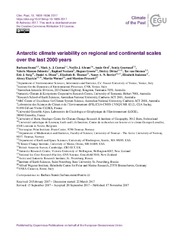| dc.contributor.author | Stenni, Barbara | |
| dc.contributor.author | Curran, Mark A.J. | |
| dc.contributor.author | Abram, Nerilie J. | |
| dc.contributor.author | Orsi, Anais | |
| dc.contributor.author | Goursaud, Sentia | |
| dc.contributor.author | Masson-Delmotte, Valerie | |
| dc.contributor.author | Neukom, Raphael | |
| dc.contributor.author | Goosse, Hugues | |
| dc.contributor.author | Divine, Dmitry V | |
| dc.contributor.author | Van Ommen, Tas | |
| dc.contributor.author | Steig, Eric J. | |
| dc.contributor.author | Dixon, Daniel A. | |
| dc.contributor.author | Thomas, Elizabeth R. | |
| dc.contributor.author | Bertler, Nancy A.N. | |
| dc.contributor.author | Isaksson, Elisabeth | |
| dc.contributor.author | Ekaykin, Alexey | |
| dc.contributor.author | Werner, Martin | |
| dc.contributor.author | Frezzotti, Massimo | |
| dc.date.accessioned | 2018-04-17T13:26:37Z | |
| dc.date.available | 2018-04-17T13:26:37Z | |
| dc.date.issued | 2017-11-17 | |
| dc.description.abstract | Climate trends in the Antarctic region remain
poorly characterized, owing to the brevity and scarcity of
direct climate observations and the large magnitude of interannual
to decadal-scale climate variability. Here, within
the framework of the PAGES Antarctica2k working group,
we build an enlarged database of ice core water stable isotope
records from Antarctica, consisting of 112 records. We
produce both unweighted and weighted isotopic (δ
18O) composites
and temperature reconstructions since 0 CE, binned
at 5- and 10-year resolution, for seven climatically distinct
regions covering the Antarctic continent. Following earlier
work of the Antarctica2k working group, we also produce
composites and reconstructions for the broader regions of
East Antarctica, West Antarctica and the whole continent.
We use three methods for our temperature reconstructions:
(i) a temperature scaling based on the δ
18O–temperature relationship
output from an ECHAM5-wiso model simulation
nudged to ERA-Interim atmospheric reanalyses from 1979
to 2013, and adjusted for the West Antarctic Ice Sheet region
to borehole temperature data, (ii) a temperature scaling
of the isotopic normalized anomalies to the variance of the
regional reanalysis temperature and (iii) a composite-plusscaling
approach used in a previous continent-scale reconstruction
of Antarctic temperature since 1 CE but applied to
the new Antarctic ice core database. Our new reconstructions
confirm a significant cooling trend from 0 to 1900 CE
across all Antarctic regions where records extend back into
the 1st millennium, with the exception of the Wilkes Land
coast and Weddell Sea coast regions. Within this long-term
cooling trend from 0 to 1900 CE, we find that the warmest
period occurs between 300 and 1000 CE, and the coldest interval
occurs from 1200 to 1900 CE. Since 1900 CE, significant
warming trends are identified for the West Antarctic
Ice Sheet, the Dronning Maud Land coast and the Antarctic
Peninsula regions, and these trends are robust across the
distribution of records that contribute to the unweighted isotopic
composites and also significant in the weighted temperature
reconstructions. Only for the Antarctic Peninsula
is this most recent century-scale trend unusual in the context
of natural variability over the last 2000 years. However,
projected warming of the Antarctic continent during
the 21st century may soon see significant and unusual warming
develop across other parts of the Antarctic continent. The
extended Antarctica2k ice core isotope database developed
by this working group opens up many avenues for developing
a deeper understanding of the response of Antarctic
climate to natural and anthropogenic climate forcings. The
first long-term quantification of regional climate in Antarctica
presented herein is a basis for data–model comparison
and assessments of past, present and future driving factors of
Antarctic climate. | en_US |
| dc.description.sponsorship | The Australian Research Council through Discovery Project DP140102059.
The PNRA (Italian Antarctic Research Programme) IPICS-2kyr-It project.
Raphael Neukom is funded by the Swiss NSF (Ambizione grant PZ00P2_154802). | en_US |
| dc.description | Source at: <a href=https://doi.org/10.5194/cp-13-1609-2017> https://doi.org/10.5194/cp-13-1609-2017 </a> | en_US |
| dc.identifier.citation | Stenni, B., Curran, M. A. J., Abram, N. J., Orsi, A., Goursaud, S., Masson-Delmotte, V., ... Frezzotti, M. (2017). Antarctic climate variability on regional and continental scales over the last 2000 years. Climate of the Past, 13(11), 1609-1634. https://doi.org/10.5194/cp-13-1609-2017 | en_US |
| dc.identifier.cristinID | FRIDAID 1546004 | |
| dc.identifier.doi | 10.5194/cp-13-1609-2017 | |
| dc.identifier.issn | 1814-9324 | |
| dc.identifier.issn | 1814-9332 | |
| dc.identifier.uri | https://hdl.handle.net/10037/12536 | |
| dc.language.iso | eng | en_US |
| dc.publisher | European Geosciences Union (EGU) | en_US |
| dc.relation.journal | Climate of the Past | |
| dc.rights.accessRights | openAccess | en_US |
| dc.subject | VDP::Matematikk og Naturvitenskap: 400::Geofag: 450 | en_US |
| dc.subject | VDP::Mathematics and natural science: 400::Geosciences: 450 | en_US |
| dc.title | Antarctic climate variability on regional and continental scales over the last 2000 years | en_US |
| dc.type | Journal article | en_US |
| dc.type | Tidsskriftartikkel | en_US |
| dc.type | Peer reviewed | en_US |


 English
English norsk
norsk